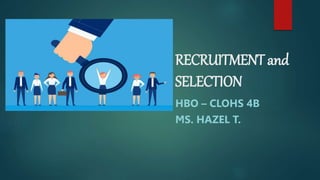RECRUITMENT and SELECTION.pptx
•Download as PPTX, PDF•
0 likes•5 views
Tourism
Report
Share
Report
Share

Recommended
Recommended
More Related Content
Similar to RECRUITMENT and SELECTION.pptx
Similar to RECRUITMENT and SELECTION.pptx (20)
· From The executive guide to high-impact talent management Power.docx

· From The executive guide to high-impact talent management Power.docx
· From The executive guide to high-impact talent management Power.docx

· From The executive guide to high-impact talent management Power.docx
Human Resource Management - Recruitment and Selection.pptx

Human Resource Management - Recruitment and Selection.pptx
RECRUITMENT and SELECTION.pptx
- 1. RECRUITMENT and SELECTION HBO – CLOHS 4B MS. HAZEL T.
- 2. Objectives 1. Discuss the need for forecasting human resource for forecasting 2. Be able to explain the steps to an effective 3. Be able to develop a job analysis and job description.
- 3. RECRUITMENT The recruitment process is an important part of human resource management (HRM). Recruitment is defined as a process that provides the organization with a pool of qualified job candidates from which to choose. It isn’t done without proper strategic planning Before companies recruit, they must implement proper staffing plans and forecasting to determine how many people they will need. The basis of the forecast will be the annual budget of the organization and the short- to long-term plans of the organization—for example, the possibility of expansion. In addition to this, the organizational life cycle will be a factor.
- 4. RECRUITMENT Forecasting is based on both internal and external factors. Internal factors 1. Budget constraints 2. Expected or trend of employee separations 3. Production levels 4. Sales increases or decreases 5. Global expansion plans External factors 1. Changes in technology 2. Changes in laws 3. Unemployment rates 4. Shifts in population Shifts in urban, suburban, and rural areas 5. Competition
- 5. RECRUITMENT RECRUITMENT STRATEGIES 1. Recruiters 2. Campus Recruiting 3. Professional Associations 4. Websites 5. Social Media 6. Events 7. Specific Interest Groups 8. Referrals
- 6. RECRUITMENT RECRUITMENT STRATEGIES 1. Recruiters 2. Campus Recruiting 3. Professional Associations 4. Websites 5. Social Media 6. Events 7. Specific Interest Groups 8. Referrals
- 7. SELECTION TYPES OF INTERVIEW 1. Traditional Interview 2. Telephone Interview 3. Panel Interview 4. Information Interview 5. Meal Interviews 6. Group Interview 7. Video Interviews 8. Nondirective Interview
- 8. SELECTION Interview Process 1. Recruit new candidates. 2. Establish criteria for which candidates will be rated. 3. Develop interview questions based on the analysis. 4. Set a time line for interviewing and decision making. 5. Connect schedules with others involved in the interview process. 6. Set up the interviews with candidates and set up any testing procedures. 7. Interview the candidates and perform any necessary testing.
- 9. SELECTION TESTING 1. Cognitive ability tests 2. Personality tests 3. Physical ability tests 4. Job knowledge tests 5. Work sample
- 10. SELECTION Make an offer • What is the scarcity of the particular skills set? • What are the “going” wages in your geographic area? • What are the current economic conditions? • What is the current pay for similar positions in your organization? • What is your organizational compensation strategy? • What is the fair market value of the job? • What is the level of the job within the organization? • What are your budget constraints? • How soon will the employee be productive in the organization? • Are there other candidates equally qualified that might have lower salaryexpectations? • What are the national and regional unemployment rates? • If you cannot pay more, can you offer other perks such as a signing bonus orflexible work schedule?
- 11. SELECTION EMPLOYMENT AGREEMENT 1. Job title 2. Salary 3. Other compensation, such as bonuses or stock options 4. Benefits, such as health-care coverage, 401(k) 5. Vacation time/paid holidays Start date 6. Non compete agreement expectations 7. Additional considerations such as relocation expenses